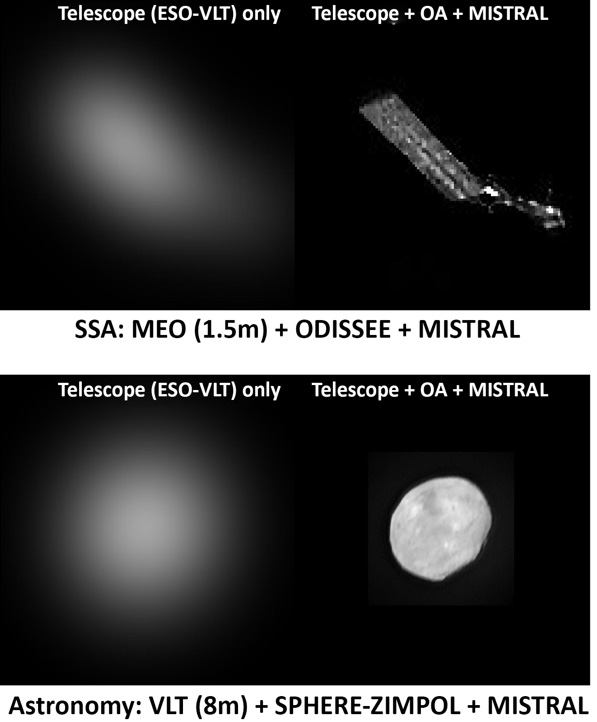Space situational awareness is a critical aspect of sovereignty. Adaptive optics and the processing of images developed by ONERA also make a significant contribution to this strategic need. The spectacular performance of the European VLT was achieved by applying these techniques to astronomy. This is specifically true for one of VLT's flagship instruments: SPHERE.
 The most recent results, which have been widely publicised, were obtained with one of the VLT 8 m telescopes, and speak for themselves: 42 small asteroids in orbit between March and Jupiter were examined in detail thanks to the adaptive ONERA optics installed on the SPHERE instrument and associated MISTRAL (and ONERA) image processing solutions. This gives us a hint as to the potential performance of a Space Situational Awareness [SSA] system designed to identify hostile satellites.
The most recent results, which have been widely publicised, were obtained with one of the VLT 8 m telescopes, and speak for themselves: 42 small asteroids in orbit between March and Jupiter were examined in detail thanks to the adaptive ONERA optics installed on the SPHERE instrument and associated MISTRAL (and ONERA) image processing solutions. This gives us a hint as to the potential performance of a Space Situational Awareness [SSA] system designed to identify hostile satellites.
Observing and identifying spatial objects in the near-earth environment (particularly low earth orbit satellites) at optical wavelengths requires a combination of the following:
- dedicated telescopes, which are large and flexible enough to track these fast-moving objects;
- a very high performance optical instrument – particularly adaptive optical systems used to avoid the unwanted effects of turbulence, such as SAXO (ONERA), fitted on the VLT SPHERE instrument;
- image processing procedures used to avoid instrumentation responses and residual errors for imaging systems.
These scientific and technical challenges are also faced in the field of astronomical observations and ONERA teams work closely with French and European observatories to develop, improve and organise the operational deployment of these systems.
The SPHERE instrument is the flagship result of this partnership. SPHERE was set up on one of the VLT 8 m telescopes in 2014 and was recently used for high resolution observations of 42 small bodies in the main asteroid belt between March and Jupiter. Key data (shape, orography and composition) was obtained thanks to this unique achievement, helping to better understand the nature of these bodies and thus more fully understand the processes at work in the formation of the solar system.
This observational achievement was only possible thanks to the combination of two ONERA products: advanced adaptive optics (SAXO, which is currently the most sophisticated operational OA system in the world) and MISTRAL, an image processing approach focusing on image processing with adaptive optic corrections.
To date, only 3 of these 42 asteroids had been observed at a very high resolution (using spacecraft), this number has now been multiplied by 14 thanks to SPHERE and MISTRAL! A resounding demonstration of the importance of the techniques developed and deployed by ONERA in this field!
These astronomy success stories combined with defence developments underway, open up the road to operational space situational awareness systems in the visible range, to complement instruments currently in use and operating at radar wavelengths.
Since the late 1970s, ONERA has worked on adaptive optics for military purposes – focusing laser beams and observing low earth orbit satellites. This unique expertise was later applied to astronomy projects, initially via Come-On, and subsequently the NAOS and SAXO (SPHERE) systems. When combined with MISTRAL. They opened up the road to some exceptional discoveries. These technologies are ready to contribute to the defence of the nation and Europe at large.




